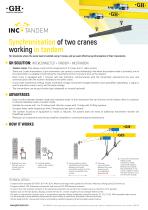 Website:
GH Cranes & Components
Website:
GH Cranes & Components
Group: Industrias Electromecánicas GH, S.A
Catalog excerpts

Synchronisation of two cranes working in tandem For situations where the same load is handled using 2 cranes, and we want effective synchronisation of their movements. GH SOLUTION: INTERCONNECTED + TANDEM = INCOTANDEM • Tandem mode: This allows control of the movements of 2 cranes from 1 radio control. • There are 2 radio transmitters. Each transmitter can control a crane individually. And when the tandem mode is activated, one of the transmitters is capable of controlling the movements of the 2 cranes (it acts as the master). • Each crane is equipped with 1 receiver with two functions: communication with the transmitter operated by the user and communication with the receiver installed on the other crane. • If any of the movements (lifting, trolley movement, bridge movement) changes between slow speed/fast speed/stop, a signal is sent to the other crane to carry out the same change. • The transmitters can be push-button type (standard) or console (optional). ADVANTAGES • Easy to switch between tandem mode and individual mode. In the transmitter that can function as the master, there is a selector to choose individual mode or tandem mode. • Suitable for cranes with 1 or 2 trolleys each. Also for cranes with 1 trolley with 2 lifting systems. • Occupies fewer radio frequencies (only 3 frequencies per pair of cranes). • The number of pieces of equipment to install is reduced. The system does not need an additional transmitter-receiver set (fixed/fixed system). • Reduction of components and wiring simplifies installation, commissioning and maintenance. 1_ Release the crane that will work as a slave from its transmitter. 2_ Activate tandem mode on the master transmitter. 3_ Communication will be established automatically between the master transmitter and each of the receivers installed in the cranes. 4_ Two-way communication between the crane receivers will be established automatically. 5_ If any of the movements (lifting, trolley movement, bridge movement) changes between slow speed/ fast speed/stop in one crane, a signal is sent to the other crane to carry out the same change. TECHNICAL DETAILS · · · · · Complies with standard EN 15011:2011+A1:2014. Maximum bridge travel speed 60 m/minute. Maximum lifting speed 20 m/minute. Frequency Band: 433-II between transmitter and receiver. EU-870 between receivers. In each crane, the auxiliary contacts of the operating contactors are wired to the receiver (up to a maximum of 16 signals). Options such as the tare button, display, console format, etc. involve a higher price and longer delivery time. For pairs of cranes with 2 trolleys each, it is possible to operate trolleys individually using the selector C1, C2, C1+C2. With standard radio remote, it is not possible to have different movements for each trolley at same time, they have to be synchronized. · Can be used both for cranes with motors controlled by variable frequency drives and dual-wound motors. GH CRANES continually improves its products and therefore reserves the right to modify this document.
Open the catalog to page 1All GH Cranes & Components catalogs and brochures
-
GH Real Time
2 Pages
-
GH catalog accessories
114 Pages
-
INDUSTRIAL SOLUTIONS
14 Pages
-
GH Corporate catalog
87 Pages
-
MARINE SOLUTIONS
14 Pages
-
Sell sheet GHE17
2 Pages
-
Sell sheet GHB11 2021
2 Pages
-
Sell sheet GHD13 2021
2 Pages
-
Sell sheet GHA12 2021
2 Pages
-
STANDARD CRANES
32 Pages
-
Trade Brochure Fairs USA
2 Pages
-
ATV+AntiSway
1 Pages
-
Transfer carts
8 Pages
-
GH´NEWS 22
28 Pages
-
Open winch
12 Pages
-
End carriages
8 Pages
-
Components
12 Pages
-
Standard kit components
6 Pages
-
Waste-to-Energy cranes
12 Pages
-
GHE17
2 Pages
-
High capacity hoists
8 Pages
-
Corebox
1 Pages
-
GH Motion
18 Pages
-
GH´NEWS 21
32 Pages
-
GH´NEWS 20
28 Pages
-
GH´NEWS 19
71 Pages
-
GH´NEWS 18
11 Pages
-
GH´NEWS 17
5 Pages
-
Electric wire rope hoist
4 Pages
-
Coreplus Synchro
1 Pages
-
Coreplus Stability
1 Pages
-
Lifting your world
24 Pages
-
Automotive marine gantries
6 Pages
-
Mailing kits
2 Pages
-
Gantry cranes
12 Pages
-
Automotive
16 Pages
-
Aeronautic
16 Pages
-
Pulp and paper industry
12 Pages
-
Waste-to-Energy cranes (zh)
16 Pages
-
Shipyard cranes
20 Pages
-
Jib cranes
8 Pages
Archived catalogs
-
Ponts roulants
13 Pages
-
Gantry cranes
12 Pages
-
Bridge cranes
12 Pages
-
Bridge cranes
12 Pages
-
Hoists
8 Pages
























































